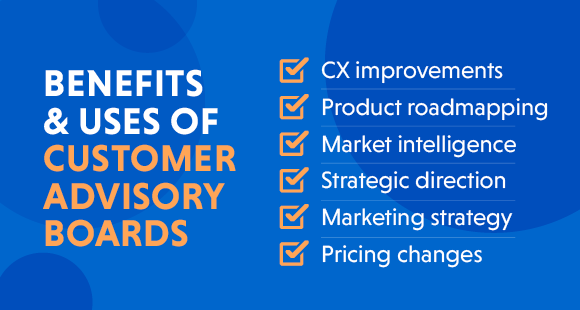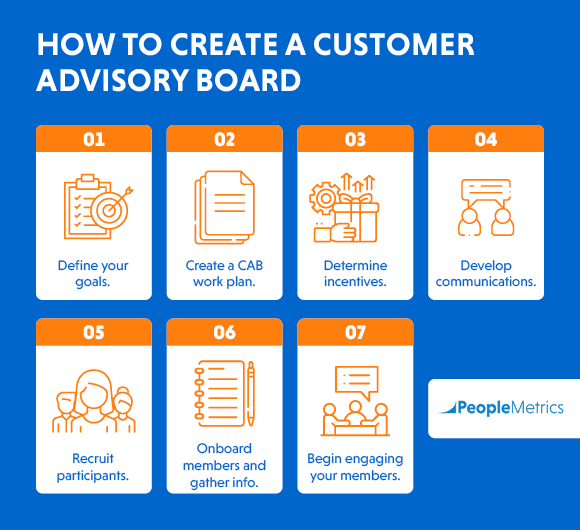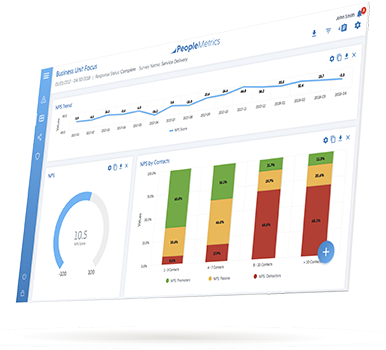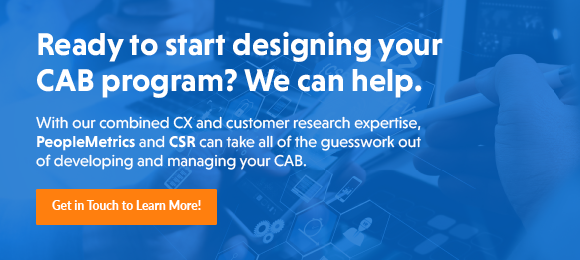Customer advisory boards (CABs) can be a powerful tool in your organization's arsenal. They can help you better guide your customer experience strategy, prepare for product launches, learn more about your audience—essentially any goal or initiative that would benefit from direct customer insight.
But what are customer advisory boards? How do they work? Is one right for your business?
This guide will answer some of the most common questions that business leaders, marketers, and product managers have about CABs:
- What are customer advisory boards (CABs)?
- What kinds of businesses create CABs?
- What are the benefits of a CAB?
- Are there different types of CABs?
- How do you create a CAB?
- What are valuable CAB questions to ask?
- How can technology and outside services help?
What are customer advisory boards?
Customer advisory boards (CABs) are special-purpose panels that consist of a business's customers and are formed for the purpose of gathering their input and opinions. The input collected through CAB interactions is then put to use to guide specific business objectives, like product roadmapping or adjusting marketing messaging.
Customer advisory boards can consist of any group of a business's customers, though they are often made up of a representative sample of its highest-impact customers whose opinions are particularly important to your organization.
The specifics of a CAB and CAB interactions are extremely flexible and can be adapted to suit a variety of business goals and contexts. CAB groups can range in size, often between 50 to 300 members. Interactions can happen on a predetermined schedule, such as monthly or quarterly (or at any point for ad-hoc needs). Input can be gathered through a range of channels like ideation sessions, online surveys, in-depth interviews, or focus groups.
Some CABs meet regularly to hold in-person meetings, but modern survey and customer experience software has made it possible to manage large CABs fully remotely. This approach requires less commitment from busy members and can yield extremely helpful continuous feedback.
What kinds of businesses create customer advisory boards?
Any business can create (and benefit from!) creating a customer advisory board to collect customer insights. CABs are particularly beneficial for companies that rely heavily on segments of high-impact customers, like:
- B2B companies that produce enterprise-level software or provide specialized professional services
- Luxury B2C brands and service providers
- Any business that operates in a niche market with relatively small pools of customers
However, even if your business doesn't fall into one of these broad categories, creating a CAB can still be a very smart move.
After all, customer feedback is gold, an invaluable asset for improving retention and guiding your strategic decisions. If your organization would benefit from increased insight into customer opinions and has the resources and capacity, creating a CAB can be an excellent investment.
What are the benefits of a customer advisory board?
Customer advisory boards are valuable because they create a direct and controllable channel for gathering customer feedback and insights. These insights can then guide and inform how you approach business objectives like:

- Customer experience improvements
- Product roadmapping
- Gathering market intelligence
- Strategic direction adjustments
- Marketing messaging strategy
- Pricing changes
And aside from the specific objectives for which you might form a CAB, directly engaging your customers and showing them how much you value their input brings several other important benefits:
- Learning more about your audience
- Increasing customer loyalty and retention
- Fostering an engaged community of customers and stakeholders
- Forming a ready-made group for customer interactions and feedback, reducing costs and recruitment slowdowns in the future
Plus, if you use customer experience and survey software to manage your CAB and facilitate interactions, you’ll also be able to maximize the value of feedback with advanced features. For example, PeopleMetrics has a proprietary content-coding process that helps businesses streamline the process of analyzing qualitative feedback from CAB members.
Overall, customer advisory boards can make excellent additions to your organization's research and listening strategies. (Or, if you don't yet have a voice-of-customer program in place, they're an easy way to get started.)
Use CABs alongside market research and proactive customer experience management. This powerful combination of data collection, continuous listening, and a focus on high-impact customers can help any business excel as a responsive, adaptable, and well-informed player in its space.
Are there different types of customer advisory boards?
Customer advisory boards are a flexible tool for businesses to learn more from their customers in support of various objectives. This means that CABs can come in all shapes and sizes depending on your goals.
The most common types of customer advisory boards, sometimes called customer advisory panels, include:
- High-impact customer boards or strategic boards. These CABs consist of your highest-impact customers and give them the opportunity to provide feedback and input on anything that might currently be important to the business.
- Customer satisfaction or experience panels. These CABs serve to collect feedback on customer satisfaction and the pain points that customers might be experiencing. You can recruit a broad cross-section of your customers or hone in on a specific segment.
- Product or service roadmap boards. These CABs are formed specifically to gather customer feedback on your products or services, how customers are using and experiencing them, potential improvements they'd find valuable, and more.
- Unbranded advisory board. Leverage the unbiased feedback of customers and prospects. This is especially useful for branding, positioning, and concept testing initiatives, when knowing who the sponsor of the initiative is could skew the feedback that’s provided.
Larger CABs that interact fully remotely are also becoming the new norm as businesses and members alike recognize the convenience and flexibility that this approach provides. Rather than collecting feedback all at once as a group, you can instead continuously collect feedback from customers to guide decisions and shape your strategies over time.
The exact type of customer advisory board you form will depend on your unique goals and business context. CAB service providers and customer research experts can also work with you to lay out a customized model tailored to your needs.
How do you create a customer advisory board?
The easiest way to create a customer advisory board is to partner with a service specialized in forming and running them. They'll follow these best practices, which you might also adapt to take a DIY approach:

1. Define your CAB goals.
Why are you forming a customer advisory board? What do you hope to learn from your customers? What is the intended outcome? Answer these questions as specifically as possible.
Clearly document these goals so that your team can keep them central to the development process and so that you can gauge your performance over time.
2. Create a customer advisory board work plan.
Once you’ve identified the goals of your CAB, the next step is to create a work plan, sometimes called a customer advisory board charter. This plan lays out the board's purpose and covers various logistical necessities. A work plan or charter can also make it easier to secure executive buy-in for the CAB in the first place.
A CAB work plan should include:
- The board's mission and scope
- The board's specific objectives and desired outcomes
- Types of customers that will make up the board and how they will be recruited
- Methodologies and cadence for interactions
- Expectations for members, including:
- Benefits
- Tenure length (often 1 to 2 years)
- Participation expectations
3. Flesh out a plan to incentivize members.
Your customers’ time is valuable, particularly B2B customers and high-impact customers. In order to ensure successful, consistent, and thoughtful participation in the board, rewards and incentives are typically offered. Monetary rewards are common practice, as are member newsletters/whitepapers and regularly sharing industry insights from other CAB interactions back to members.
Members also often value the fact that you care enough to gather their feedback. The ability to weigh in on strategic decisions and be looped into your findings can also be immensely rewarding for many members.
4. Develop communications for recruiting and interacting with members.
Take the time to develop a communications strategy for your CAB. How will you communicate with members? This could be very different depending on whether your CAB is branded or unbranded. Will communications happen via telephone, text messaging, email, social media, online surveys? Who will communications come from?
Deciding on and sticking to a consistent, standard method of communication will be important.
Next, what will you say? Setting clear expectations is also very important (as is following through with your end of those expectations). Initially, as part of recruiting, you’ll want to communicate expectations and parameters developed in the work plan, i.e. desired tenure, member benefits, etc.
Be sure to tell members what they can expect from the experience, too. Many CABs promise confidentiality and autonomy to members unless otherwise specified. This allows for more open and honest feedback from members.
Also consider creating an online membership portal or other central location where members can access background materials, meeting reports, and more.
5. Recruit your participants intentionally.
Next, begin inviting customers to join the CAB. Since there are specific goals you want to accomplish with your CAB, identifying and recruiting participants intentionally will yield better long-term results than taking a randomized or scattershot approach.
Are you looking to learn from a specific segment, like high-impact customers? If so, how will you define that segment? Do you need high-impact customers with whom you have long relationships, fairly new relationships, or a mix?
Or are you looking to learn from a broader cross-section of customers? What criteria will make them eligible? For instance, you may aim to recruit X number of customers in each predefined lifetime value segment who've made a purchase in the last X months.
Once you define the customer segment(s) you want to invite, identify specific individuals and recruit them to be part of the board.
6. Onboard members and gather background information.
It can be helpful to collect background, demographic, and other experience data from members. Not only will this give you a deeper sense of who is on the board but also, depending on the size of the board, you may be able to identify trends by subset groups of members based on this background data.
After recruiting members, create an initial “onboarding” survey that allows you to dig into and gather background, demographic, and other experience data from members. Also ask members about their familiarity with the various areas that you want their feedback on and their hopes for the CAB. Offer the opportunity to provide some initial suggestions for topics that they're particularly interested in.
Customer experience software can simplify this entire process and save all survey insights (including those you conduct as part of the normal feedback collection process) for future reference.
7. Begin engaging members with the right interaction methodologies and cadences.
You've already laid out a plan for how and how often you will interact with members. Now it’s time to begin gathering insights!
What are the best methodologies for interacting with members? What is a good cadence of interactions? The answers, obviously, are often specific to your organization and its goals for the CAB. The ability and pace of your organization to come up with topics and finalize surveys for interactions should be taken into consideration.
When thinking of CAB methodologies, let your goals guide your choices. You have many tools in your toolbox for options, including quantitative online surveys, in-depth interviews, video focus groups, etc. You can leverage multiple types of methodologies with members as long as you’ve set those expectations with them.
Typical CABs engage members at least monthly. In order to maximize value and engagement, you want a frequency that is not overwhelming for members, but enough that members don’t forget about the board! You should also take into account the type of customers that comprise your board. B2B customers’ time is very valuable and most likely, they will be interacting with you during the workday.
You can be flexible with the specific touchpoints that you build into your CAB process. But remember, keeping members engaged will ultimately lead to more productive and valuable interactions since they'll have been actively thinking about their experience with your business.
What are valuable customer advisory board questions to ask?
The specific questions and topics you cover in customer advisory board interactions will vary based on the board's purpose, like messaging, product roadmapping, or high-impact customer experience.
However, it's still important to get the ball rolling with flexible, open-ended questions. To keep your interaction cadences running smoothly and ensure every board member has an opportunity to provide input, ask questions like:
- What are your/your organization's goals this year?
- How can our business support those goals?
- What new offerings or features would you find valuable?
- Where are there gaps or pain points in the experience we offer?
- What other tools, products, or services do you use?
- Do you feel equipped to succeed with our offerings, or are there areas where we can offer stronger support?
- How likely are you to recommend us to peers?
As you create and adapt your CAB questionnaires over time, keep a running list of go-to questions like these that your team can draw upon to kickstart conversations and collect qualitative feedback.
How can technology and outside services help?
Multiple tools can support your CAB program. Board management platforms, document sharing tools, and event management software will all be valuable additions to your CAB toolkit, for instance.
The best technology investment you make for your customer advisory board, however, is in robust customer experience software.
PeopleMetrics is a leading CX platform that allows you to create custom automated surveys for continuous CAB engagement and data collection. Feedback is compiled into intuitive analytics dashboards for immediate takeaways and easy reporting. This foundational tool will give your CAB program a reliable feedback collection channel—plus the data features you need to drive productive interactions, analyze trends, and make compelling cases to the rest of your team.
Professional customer advisory board services can also be a smart choice for businesses that are new to CABs, don't have the capacity to manage them closely themselves, or simply want an expert's touch. These services can:
- Design your CAB program from the ground up
- Lay out your CAB work plan
- Help you identify and recruit members
- Design survey and communication cadences
- Manage and maintain your CAB
- Conduct member interactions
- Analyze and report on findings
The PeopleMetrics CX platform and our Center for Strategy Research division can give you everything you need to get up and running with a customer advisory board quickly. Our support takes the guesswork out of developing, implementing, and managing CABs, freeing up your time to focus on what's most important—learning more about your customers, engaging your board members, and acting on their feedback.
Want to learn more? Get in touch to discuss your CAB goals. We'll get started designing the perfect solution for your business.
To learn more about how customer feedback can give your business the cutting edge, keep exploring with more resources from PeopleMetrics:
- What is Customer Experience? Complete Introduction to CX
- 3 Trends in CX and High-Impact Customers
- How to Align Customer Experience and Market Research
- 3 Strategies for Turning Your Customers into Promoters








%20(1).png)